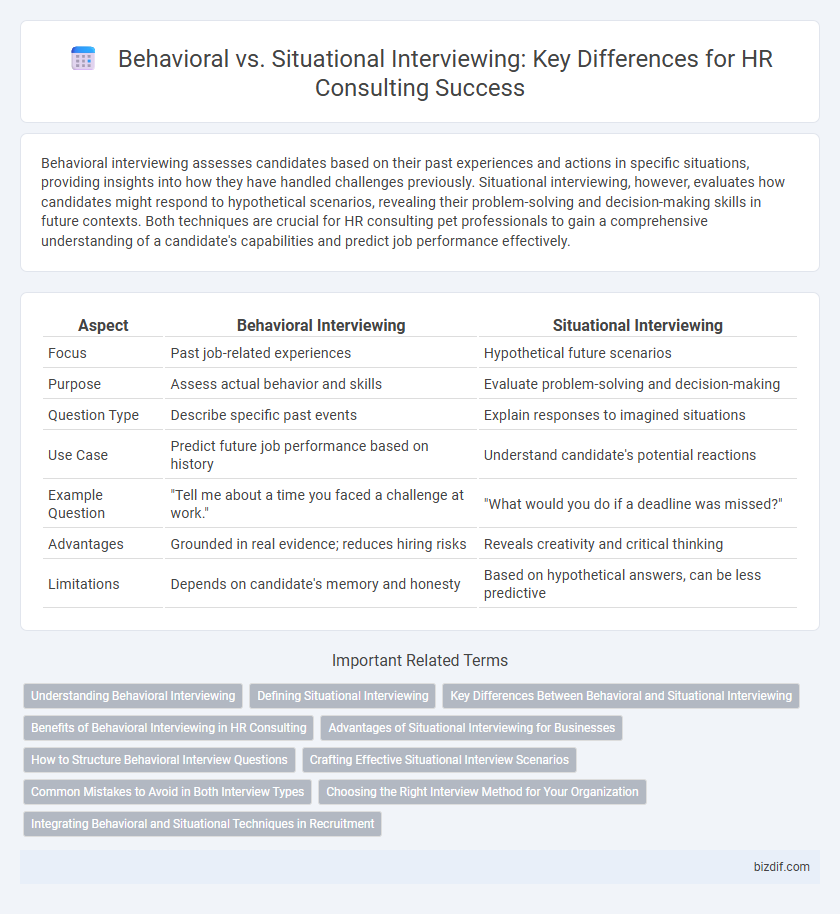Behavioral interviewing assesses candidates based on their past experiences and actions in specific situations, providing insights into how they have handled challenges previously. Situational interviewing, however, evaluates how candidates might respond to hypothetical scenarios, revealing their problem-solving and decision-making skills in future contexts. Both techniques are crucial for HR consulting pet professionals to gain a comprehensive understanding of a candidate's capabilities and predict job performance effectively.
Table of Comparison
| Aspect | Behavioral Interviewing | Situational Interviewing |
|---|---|---|
| Focus | Past job-related experiences | Hypothetical future scenarios |
| Purpose | Assess actual behavior and skills | Evaluate problem-solving and decision-making |
| Question Type | Describe specific past events | Explain responses to imagined situations |
| Use Case | Predict future job performance based on history | Understand candidate's potential reactions |
| Example Question | "Tell me about a time you faced a challenge at work." | "What would you do if a deadline was missed?" |
| Advantages | Grounded in real evidence; reduces hiring risks | Reveals creativity and critical thinking |
| Limitations | Depends on candidate's memory and honesty | Based on hypothetical answers, can be less predictive |
Understanding Behavioral Interviewing
Behavioral interviewing centers on assessing past actions and experiences to predict future job performance, emphasizing specific examples candidates provide about how they handled work situations. This technique relies on the premise that past behavior is the best indicator of future conduct, enabling HR professionals to evaluate competencies such as problem-solving, teamwork, and communication. In contrast to situational interviewing, which hypothesizes responses to hypothetical scenarios, behavioral interviewing delivers concrete evidence through verified past behaviors, enhancing the accuracy of candidate assessments.
Defining Situational Interviewing
Situational interviewing is a structured HR consulting technique that assesses a candidate's problem-solving skills by presenting hypothetical, job-related scenarios requiring specific responses. This method evaluates future behavior and decision-making abilities, distinguishing it from behavioral interviewing, which focuses on past experiences. Situational interviewing improves predictive accuracy for job performance by simulating real workplace challenges in a controlled, interview environment.
Key Differences Between Behavioral and Situational Interviewing
Behavioral interviewing evaluates candidates based on past experiences and specific actions in real situations, emphasizing proven skills and behaviors. Situational interviewing focuses on hypothetical scenarios to assess problem-solving abilities and how candidates might handle future challenges. These core differences impact the prediction accuracy of future job performance by either grounding assessments in reality or projecting potential responses.
Benefits of Behavioral Interviewing in HR Consulting
Behavioral interviewing in HR consulting provides a data-driven approach by focusing on candidates' past experiences, which offers predictive insights into future job performance. This method enhances the accuracy of talent acquisition by reducing biases and uncovering practical skills and problem-solving abilities directly relevant to the role. Employers benefit from improved employee retention and productivity through selecting individuals whose proven behaviors align with organizational values and job demands.
Advantages of Situational Interviewing for Businesses
Situational interviewing offers businesses the advantage of predicting future job performance by assessing candidates' problem-solving abilities and decision-making skills in hypothetical scenarios relevant to the role. This technique enhances the accuracy of hiring decisions by focusing on how candidates might handle real workplace challenges, reducing the risk of employee turnover. Companies that implement situational interviews often experience improved talent acquisition outcomes and increased organizational efficiency.
How to Structure Behavioral Interview Questions
Behavioral interview questions should be structured using the STAR method (Situation, Task, Action, Result) to elicit detailed examples of candidates' past experiences and demonstrate their competencies. Focus on specific past behaviors related to job-relevant skills by asking candidates to describe the context, their role, the actions they took, and the outcomes achieved. This approach provides measurable evidence of performance and helps predict future success in similar scenarios.
Crafting Effective Situational Interview Scenarios
Crafting effective situational interview scenarios involves designing questions that replicate real workplace challenges candidates are likely to face, emphasizing problem-solving and decision-making skills. Situational interviewing focuses on hypothetical situations, allowing HR professionals to assess a candidate's ability to apply knowledge and adapt to evolving contexts, unlike behavioral interviewing which reviews past experiences. Well-developed scenarios align with key job competencies, enhancing predictive validity and ensuring a more accurate evaluation of candidate potential.
Common Mistakes to Avoid in Both Interview Types
Common mistakes to avoid in behavioral and situational interviewing include asking overly vague questions that fail to elicit specific examples or clear problem-solving approaches, leading to incomplete candidate assessments. Interviewers often neglect to prepare structured follow-up questions, which can result in missed opportunities to explore critical competencies or past experiences thoroughly. Failing to maintain consistency by applying different evaluation criteria across candidates undermines the reliability and fairness of both interview types.
Choosing the Right Interview Method for Your Organization
Behavioral interviewing assesses candidates based on past experiences and demonstrated skills, providing insights into how they handled specific situations relevant to the role. Situational interviewing evaluates potential responses to hypothetical scenarios, predicting future behavior in job-related challenges. Selecting the right method depends on your organizational goals, job complexity, and the need to gauge past performance versus problem-solving abilities in unfamiliar contexts.
Integrating Behavioral and Situational Techniques in Recruitment
Integrating behavioral and situational interviewing techniques enhances recruitment by combining past experience analysis with hypothetical scenario evaluation to predict candidate performance more accurately. Behavioral interviewing focuses on specific examples of previous job behavior, while situational interviewing assesses potential responses to future work challenges. Leveraging both methods provides a comprehensive insight into candidates' skills, adaptability, and problem-solving abilities, leading to better hiring decisions and reduced turnover.
Behavioral Interviewing vs Situational Interviewing Infographic

 bizdif.com
bizdif.com